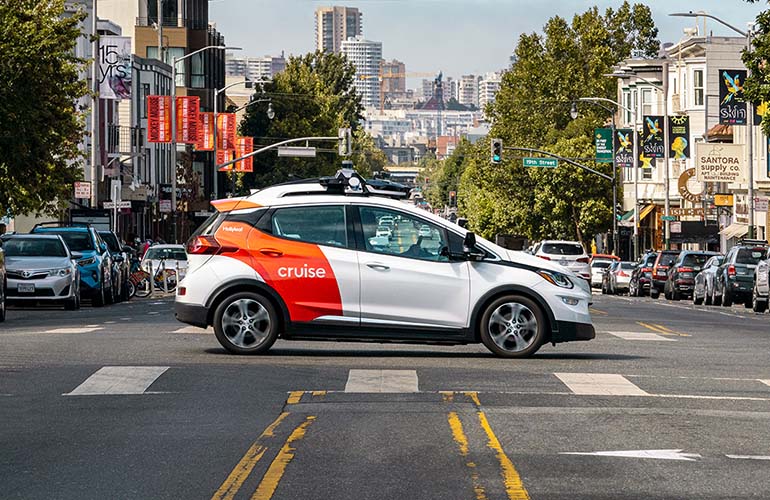|
Listen to this article  |

A Cruise robotaxi operating in San Francisco. | Credit: Cruise
Cruise and Waymo, two leading autonomous vehicle companies, on Thursday both received permits to offer robotaxi rides to public passengers in California. The approval from the California Department of Motor Vehicles (DMV) does, however, come with major caveats.
Cruise’s permit allows five of its robotaxis to drive passengers around certain parts of San Francisco. Cruise vehicles are approved to operate between 10 PM and 6 AM at a maximum speed of 30 MPH. The DMV is allowing Cruise to drive its robotaxis in light rain and fog. Cruise has been able to test autonomous vehicles on California’s public roads with a safety driver since 2015 and to test autonomous vehicles without a driver since October 2020.
Waymo’s permit allows it to operate its autonomous vehicles in certain parts of San Francisco and San Mateo counties. However, the vehicles must have human safety drivers behind the wheel. Waymo’s vehicles are approved to operate on public roads with a speed limit of no more than 65 MPH and can also operate in rain and light fog. The DMV didn’t specify a timeframe in which Waymo’s vehicles could operate.
To start charging passengers for rides, Cruise and Waymo also need to obtain another permit from the California Public Utilities Commission (CPUC) to start charging passengers for rides. Apparently Cruise’s approval from the CPUC is still pending.
Waymo has been OK’d to test autonomous vehicles on California’s public roads with a safety driver since 2014 and received a driverless testing permit in October 2018. Waymo started public testing in San Francisco in August 2021 with human safety drivers behind the wheel. Waymo has been operating a Level 4 public robotaxi service in parts of Arizona since October 2020.
“We can only offer paid rides in driverless AVs to members of the public during those hours (pending the final CPUC deployment permit),” a Cruise spokesperson said. “We can continue to test with or without passengers in both driverless and with drivers 24/7. We will coordinate with our regulators as we expand hours of operations and geographic corridors.”
Another autonomous vehicle company, Nuro, received a similar permit from the California DMV in 2020. But Nuro’s permit is for delivery of goods, not passengers. FedEx is now testing Nuro’s autonomous delivery vehicles.
More than 50 companies are licensed to test autonomous vehicles in California. Autonomous vehicles in California traveled approximately 1.99 million miles in autonomous mode on public roads in 2020. The total miles driven by Waymo and Cruise, 1.39 million, is 70% of the total autonomous miles driven in California in 2020.
In March 2021, Cruise acquired autonomous vehicle startup Cruise. Terms of the acquisition were not disclosed. Founded in 2017, Voyage raised about $52 million, while Cruise has raised about $8 billion. Voyage was able to stand out by operating its adapted Chrysler Pacifica Hybrid minivans in two retirement communities: a 4,000-resident retirement community in San Jose, and a 40-square-mile, 125,000-resident retirement city in Florida.
Credit: Source link


Comments are closed.